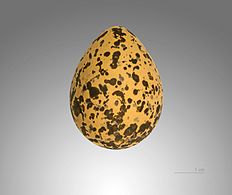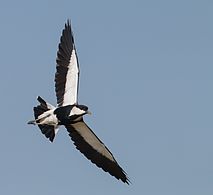| Spur-winged lapwing | |
|---|---|
_Gambia.jpg) | |
| in Gambia | |
| Calls recorded at Lake Turkana, Kenya | |
| Scientific classification | |
| Kingdom: | Animalia |
| Phylum: | Chordata |
| Class: | Aves |
| Order: | Charadriiformes |
| Family: | Charadriidae |
| Genus: | Vanellus |
| Species: | V. spinosus |
| Binomial name | |
| Vanellus spinosus (Linnaeus, 1758) | |
| Synonyms | |
| Charadrius spinosus Linnaeus, 1758 | |
The spur-winged lapwing or spur-winged plover (Vanellus spinosus) is a lapwing species, one of a group of largish waders in the family Charadriidae.
It is one of several species of wader supposed to be the "trochilus" bird said by Herodotus to have been involved in an unattested cleaning symbiosis with the Nile crocodile.
Distribution
The spur-winged lapwing breeds around the eastern Mediterranean, and in a wide band from sub-Saharan west Africa to Arabia. The Greek and Turkish breeders are migratory, but other populations are resident. The species is declining in its northern range, but is abundant in much of tropical Africa, being seen at almost any wetland habitat in its range. The spur-winged lapwing is one of the species to which the Agreement on the Conservation of African-Eurasian Migratory Waterbirds (AEWA) applies.
Description
These are conspicuous and unmistakable birds. They are medium-large waders with black crown, chest, foreneck stripe and tail. The face, the rest of the neck and belly are white and the wings and back are light brown. The bill and legs are black. Its striking appearance is supplemented by its noisy nature, with a loud did-he-do-it call. The bird's common name refers to a small claw or spur hidden in each of its wings.
Ecology and behaviour
This species has a preference for marshes and similar freshwater wetland habitats. The food of the spur-winged lapwing is insects and other invertebrates, which are picked from the ground.
It lays four blotchy yellowish eggs on a ground scrape. The spur-winged lapwing is known to sometimes use the wing-claws in an attack on animals and, rarely, people, who get too close to the birds' exposed offspring.
Supposed cleaning symbiosis
The "spur-winged plover" was identified by Henry Scherren as the "trochilus" bird said by the Greek historian Herodotus[2] to be involved in what would now be called a cleaning symbiosis with the Nile crocodile.[3] However, there is no reliable evidence that this or any other species in fact has such a relationship.[4]
Gallery
References
- ^ BirdLife International (2012). "Vanellus spinosus". IUCN Red List of Threatened Species. 2012. Retrieved 26 November 2013.
- ^ Herodotus. "The Histories of Herodotus". Book II: Euterpe. Ancient Worlds. pp. 2:68. Archived from the original on 19 July 2012. Retrieved 12 February 2012.
- ^ Scherren, Henry (1906). Popular Natural History. Cassell. p. 268.
Mr. J.M. Cook, of the celebrated tourist agency, when in Egypt in 1876, "watched one of these birds, and saw it deliberately go up to a crocodile, apparently asleep, which opened its jaws. The bird hopped in, and the crocodile closed its jaws. In what appeared to be a very short time, probably not more than a minute or two, the crocodile opened its jaws, and we saw the bird go down to the water's edge." There were several of these birds about, and Mr. Cook shot two of them, which Dr. Sclater identified as Spur-winged Plovers; so that the question as to what bird enters the mouth of the crocodile is now set at rest.
- ^ Macfarland, Craig G.; Reeder, W.G. (1974). "Cleaning symbiosis involving Galapagos tortoises and two species of Darwin's finches". Zeitschrift für Tierpsychologie. 34 (5): 464–483. doi:10.1111/j.1439-0310.1974.tb01816.x. PMID 4454774.
External links
- BirdLife species factsheet for Vanellus spinosus
- "Vanellus spinosus". Avibase.

- "Spur-winged lapwing media". Internet Bird Collection.
- Spur-winged lapwing photo gallery at VIREO (Drexel University)
- Interactive range map of Vanellus spinosus at IUCN Red List maps
- Audio recordings of Spur-winged lapwing on Xeno-canto.




_(21152292885).jpg)
_in_flight.jpg)
